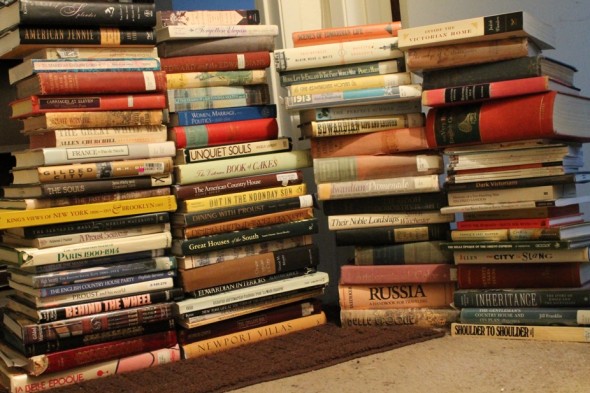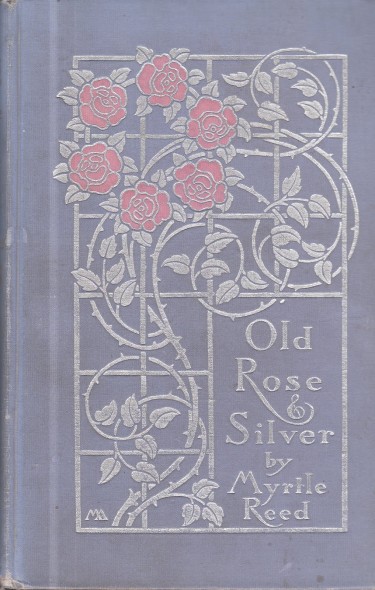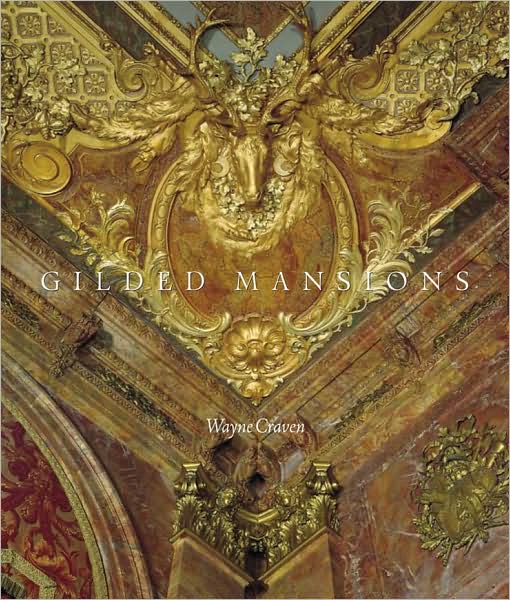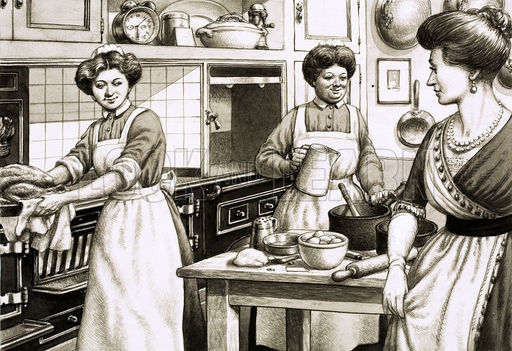Taking a cue from the owner of the Julian Fellowes’ Titanic fanpage, as well as the number of lists recommending Downton Abbey/Edwardian/WWI-themed books (and stay tuned for the list Melody and I are curating), I decided it was a great time to brag about display my research library. This, my readers, is the result of nearly eight years of my Edwardian obsession that began when I was in my very early twenties–and I haven’t even taken pictures of my stash of Baedeker and Murray travel guides from the early 1900s (or…*gulp* the number of e-books on my hard drive)! Granted, this is nothing compared to some of the various collections I’ve seen–and drooled over–belonging to historians or costumers or hobbyists, so I’m always finding excuses to buy more books.
To give a general overview of this massive stack of books:
- Most have been purchased secondhand from Amazon, Abebooks, eBay, or library book sales
- The leading topics are (in order of quantity): Edwardian England, Gilded Age New York, Belle Epoque France, African-American/Progressive Era topics, Costumes, and Architecture/Interiors
- The most expensive book purchased has been my 1914 edition of Baedeker’s Egypt ~$80; the least expensive was my copy of Lord Grey of Fallodon’s memoirs $1.00
- Earliest purchase: The Reminscences of Lady Randolph Churchill by Mrs. Cornwallis West in 2005; Most recent purchase: Twenty Shillings in the Pound by W. J. MacQueen-Pope
- Oldest book: 1890 edition of Badeker’s Great Britain; Newest book: Inheritance: The Story of Knole and the Sackvilles, By Robert Sackville-West (2010)
My advice for anyone wanting to build their own research library–on any topic–is to search for general overviews first (and these tend to be less expensive than specialized titles), look through the bibliographies of those books you find most useful, and then shop around for the best price (and check to see if some of those titles are in the public domain). I’ve let some highly coveted books go because I didn’t feel they were worth the high prices, and then months or even a year or two down the road, I find a much cheaper copy! And remember, this is years worth of collecting–don’t feel pressured to buy everything at once (I did that the first year and my wallet howled).






Great Advice! I”ve got another suggestion for deeper research: Books available online.
For example: I’m the Ford Madox Ford fan who keeps recommending “Parade’s End.” Ford was quite prolific & much of his work is out of print. “Memories and Impressions” is a memoir of his pre-Raphaelite boyhood; Ford Madox Brown, part of the group if not of the PRB, was his grandfather. You can read it online or download it in various formats. http://www.archive.org/details/memoriesimpressi00ford
A quick search for “Edwardian” got 96 hits–although some relate to an earlier Edward. I”m a firm believer in the printed word, as the piles of books at home will attest. But there’s more than one way to get information. And determine which books are worth hunting down from used book merchants…
Definitely. I do have a ton of public domain e-books on my laptop (I had to buy an external hard drive to store them all), and am thankful to Google Books, Internet Archive, etc et al for providing them for history and research nuts like myself.
Love book hunting. I have some hard to finds that others have been kind enough to find for me and send. I have found other’s in corners of new and used book stores. Sooner or later most books can be found.
Nobody comes book shopping with me… I can spend hours in a book store. Doesn’t matter if they are new or used.
Me too! I have to set aside time to go exploring in my local UBSs because I can easily lose track of time.
oh agreed! My favourite treasure is The Edwardians: Secrets and Desires, published by the National Gallery of Australia. I buy all my history and art books in second hand shops, and never want to leave *sigh happily*.
But the house does become full! I had to wait till the children married, before I could turn their bedrooms into libraries.
Ooh! I’ve been looking at that book for a while, unsure of whether it’d be worth the postage to buy it.
And yes, books do fill the house to capacity. I’m living in an apartment and we’re constantly shifting our individual book collections around the place, lol.
You have an enviable collection!
Can I ask a silly question? I’m luckily enough to have excellent lending libraries in my city and but I’ve struggled to find a note taking technique that works for me. How do you make notes from your books?
BTW highly recommend Jeffrey Green’s book Black Edwardians (you may have read it but I didn’t see it among your book stacks) for a glimpse into the lives of the 60,000 people of African descent living in the UK before WW1.
That’s not a silly question at all! I usually begin by skimming through the book–looking at the table of contents, flipping to the index for particular topics, and reading sections that catch my eye. I then go through the book, chapter by chapter, first skimming to pick up the natural sections within the chapter, and secondly, checking for repetition. Then I grab my pen and notebook and start taking notes using the “A. I. 1. a. i. 1.” method. I definitely do not recommend taking notes “cold”–you’re bound to feel overwhelmed by the task and either miss vital information or write down extraneous bits. Sometimes, if the book is easy to read, I just read the entire thing, marking interesting facts with Post-It flags, and then I go back and take notes. I find that reading the book first and then taking notes helps me retain information better, but you may learn differently than I do! Hope this helps. 🙂
(And I have read the Green book–it’s just so expensive and my library owns a copy, so I haven’t found an excuse to purchase it).
I agree starting general and working your way toward the specific is excellent advice. I always do things bass-akwards, though, so it never works out that way for me. 😉 I usually start with a very specific question about an object or artist and then work my way outward from that. Museum, historical society, and old newspaper websites are great resources for research, as well.
Lol. I do sometimes seek the specific before the general, but that’s only because I know the Edwardian period so well, I don’t need to know the context of the specific topic. And my fondest wish is to have the money to travel to any research library I desire and pour over their archives (first stop, New York Public Library).
Wow! You’ve got quite a collection there.
I have a few books. I only started collecting historical reference books in the past year, so I guess I have a way to go.
@Kiru Thanks! Like I said, this didn’t happen overnight and there are plenty of books I have yet to purchase!
i love to see a big stack of books…history,biography,art,design…i can just lose my self in them…
@Ree Sometimes I do lose myself in them. I pick one up intending to read only one particular passage and I look up and realize I’ve read an entire chapter. 😉
What a lovely stack of books! It’s like writer porn.
You’re right about books filling up a house. We have 2500 sf, and we still had to switch to e-readers because we’re out of room.
@Marlene It is, haha. I do read e-books, but I must own my non-fiction titles in paper so that I can fill the pages with stick notes.
Thanks for the tips Evangeline, can’t wait to put them into practice!
@lasca You are welcome! Let me know if you still have any questions.
Yummy! Please HELP anyone. What is the book set in Scotland, WWI, involves Siegfried Sassoon(?) and at plastic surgery hospital?? Thought it was Olivia Manning but no. Thanks in anticipation.
thanks all …. must be something like washing the car makes it rain, found it immediately as soon as I left this site – Regeneration by Pat Barker.
@kerry Glad you remembered it. 😀
How about The Regeneration Trilogy?
You have a wonderful collection! And thank you for the tips.
Yes, the Regeneration Trilogy uses some “real” characters–including Siegfired Sassoon, Wilfred Owen & Robert Graves. Craiglockhart War Hospital was set up to treat officers suffering from “neurasthenia”–one of the terms for what was also called Shell Shock. Or Battle Fatigue in the later War & PTSD nowadays.
Although the physical effects of a close hit by a shell–as suffered by Ford Madox Ford & his hero in Parade’s End–was also called Shell Shock.